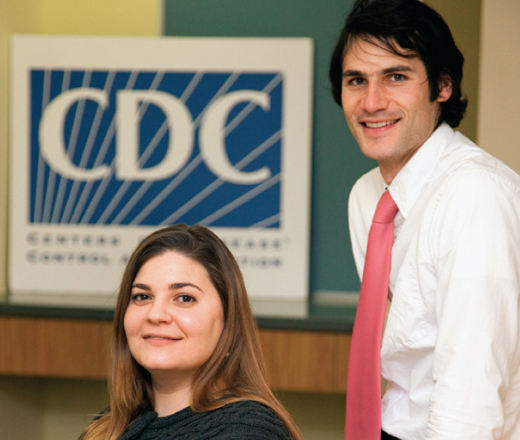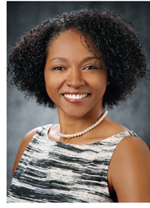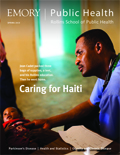Alumni begin national conversation on chemical safety

Left: Kim DeFeo and Ben Gerhardstein. Below: Montrece Ransom.

Ben Gerhardstein 08MPH helped get the conversation rolling. Montrece Ransom 09MPH joined in next, followed by Kim DeFeo 09MPH. Now they are engaging the nation in a critical discussion on chemical exposures and health.
The Rollins alumni, all current or former Presidential Management Fellows, are among the four CDC staff members who are moderating the National Conversation on Public Health and Chemical Exposures. Sponsored by the CDC’s National Center for Environmental Health (NCEH)/Agency for Toxic Substances and Disease Registry (ATSDR), the two-year project involves members of government, professional organizations, tribal groups, community and nonprofit organizations, and the public. Their goal: to develop an action plan to better use and manage chemicals safely and protect Americans’ health.
When Gerhardstein joined NCEH/ATSDR in 2008, the conversation consisted of a few bullet points on a sheet of paper. “The impetus for the project came from a desire by NCEH/ATSDR to take a hard look at 25 years of work in this area—are we doing the best job based on modern science and what we know works in practice,” he explains. “It quickly came to have a life of its own.”
The project evolved to include several key partners, a leadership council, and six work groups comprised of 180 public health and environmental health experts from around the United States. Each work group is researching issues to form recommendations in their respective areas: monitoring, scientific understanding, policies and practices, chemical emergencies, serving communities, and education and communication.
Gerhardstein coordinates several aspects of the National Conversation project, from working with the leadership council to members of his own agency. Ransom, an attorney and former Presidential Management Fellow, manages the policies and practices and the chemical emergencies work groups, stemming from her experience with the Public Health Law program, based in the CDC’s Office of the Director. Since joining that office nine years ago, Ransom has worked on issues in environmental health and public health emergency preparedness. Her experience proved to be a good fit for the work groups she now manages.
“This has been a learning experience for me,” says Ransom. “I’m learning about the issues that confront people in the area of chemical exposures while helping work group members who are experts in the field figure out where the gaps are and where we should be headed in the future.”
DeFeo, who manages the work groups on scientific understanding and serving communities, works with Gerhardstein and others to broaden project participation around the country. This spring, the public will weigh in on the National Conversation through a web forum. Over the course of a few days, key questions will be posted to generate what’s expected to be “robust” discussion among hundreds of people online. While the CDC has conducted similar discussions before, “this is the first time we’ve done this in the environmental health arena,” says Gerhardstein.
To complement the web discussion, DeFeo is developing a toolkit to guide community conversations of eight to 10 people in neighborhoods, churches, and schools. “The idea,” says DeFeo, “is to bring people together around the country to learn what their concerns are and what they see as solutions to protect them from chemical exposures.”
As the National Conversation moves forward, the leadership council and work groups will share their ideas and recommendations in a draft report for public comment in order to create a final action agenda by early next summer.
“We want the work group reports and the final action agenda to be specific and not just pie-in-the-sky thinking,” says Gerhardstein. “We’re looking for recommendations that we can make work to protect the public’s health.”—Pam Auchmutey


